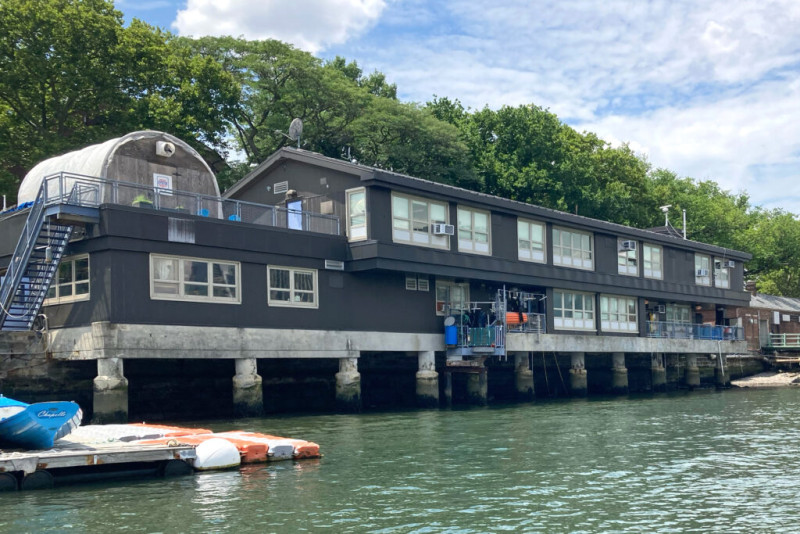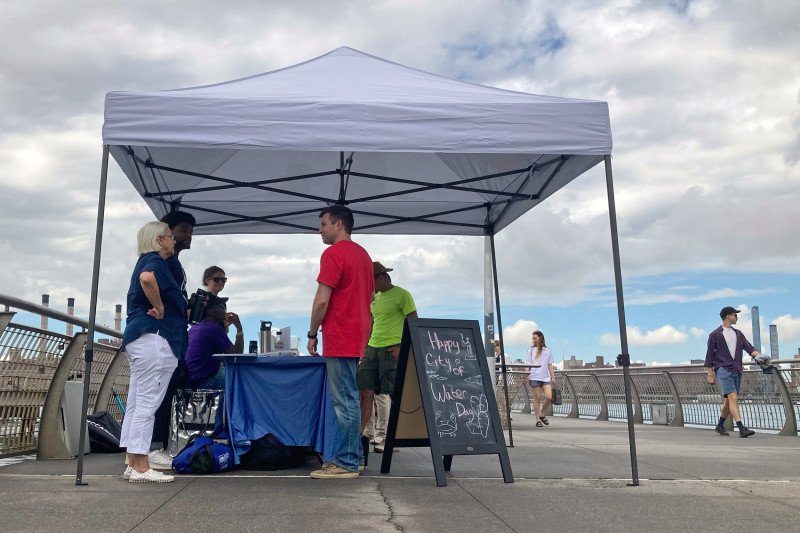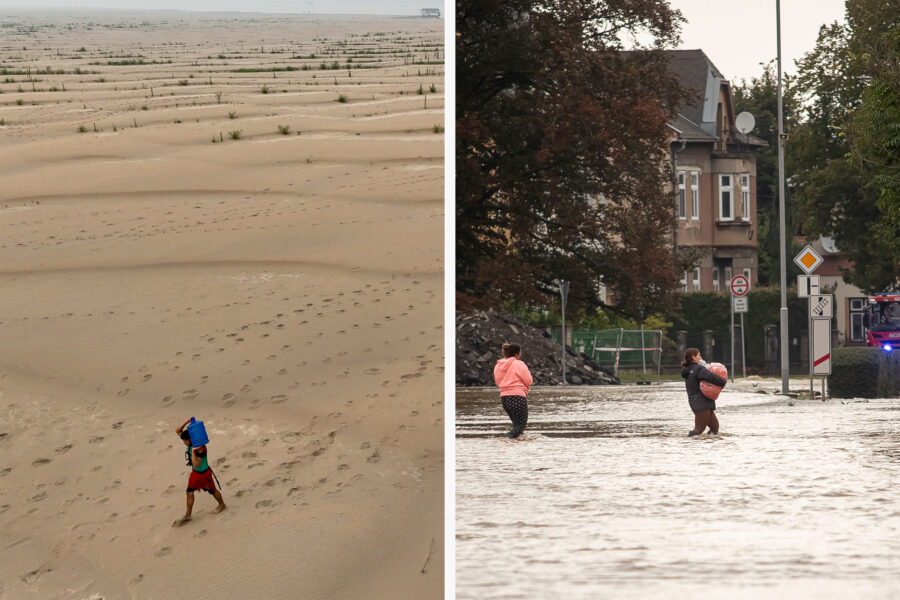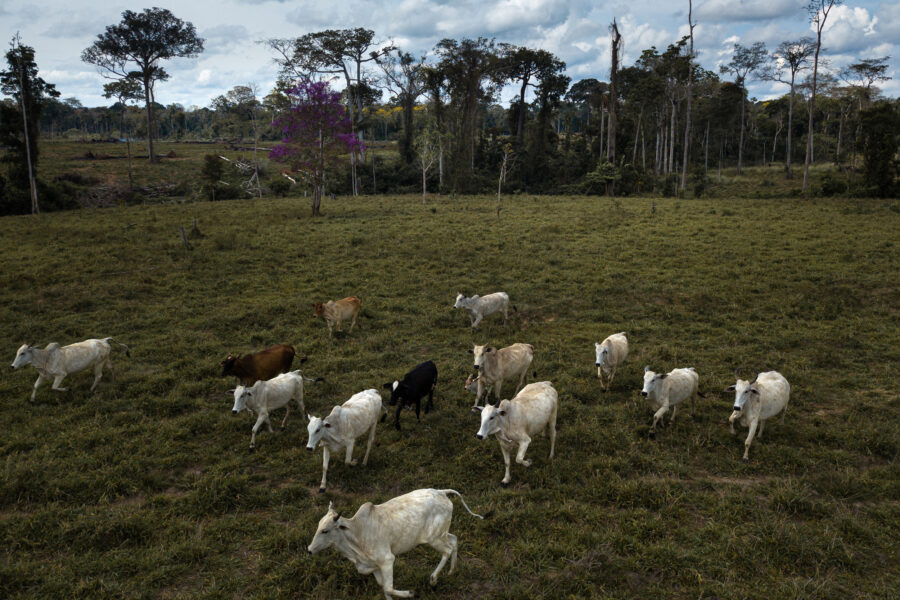For Marine Species Across New York Harbor, the Oyster Is Their World
A small boat sped down the Hudson River as passengers admired the views of lower Manhattan skyscrapers and the open water. Occasionally, the boat rebounded high into the air as it bounced off the waves from the ferries operating in the waterway, causing the more inexperienced boaters to lurch forward.
Pete Malinowski, executive director and co-founder of an expansive oyster restoration project in the city, barely flinched.
The boat, which belongs to Malinowski’s Billion Oyster Project, has been dubbed “Attractive Nuisance.” It’s a nod to the ways in which regulators view the inedible oysters that Malinowski has been restoring in the bay—a possible threat to the health of hungry passersby who may be tempted to eat them.
The boat pulled into Brooklyn Bridge Park, which hosts one of the project’s many field stations. There, a cage holds oysters, which project volunteers use to monitor survival and growth at the site, and where school kids and community members can see all sorts of growing marine flora and fauna.
Explore the latest news about what’s at stake for the climate during this election season.
“It’s here to see how the oysters survive,” said Malinowski of the riverside lab. “We’ll sample them every year to make sure that they’re able to reproduce, that they’re reproducing effectively, and just to get an idea of growth rates over time, survival rates over time.”
Malinowski has an easy smile, and a rugged yet welcoming disposition that befits the leader of an initiative focused on public education. Walking across the pier, he cheerfully pulled from the water a SEAPA cage, a cylindrical steel apparatus which contained seeded oyster shells and a variety of other marine species, like mud crabs. Hanging in the water, they are attached to the pier using a thick rope that makes it easy for volunteers to pull them up and check on the mollusks.
“We put thousands and thousands of tiny, tiny oysters in here and, over time, things eat them,” said Malinowski. “They grow around each other, and the fastest growing oysters survive and go through the edge” of the cage.
Over time, the structures attract a diverse group of marine species, many of which feed on the oyster larvae and use the cage to hide from predators and to reproduce.
“What you see by the end of the summer is that every inch of the cage will be covered in living things,” Malinowski said.
Malinowski grew up helping out at his family’s oyster farm on Fishers Island, a small island in the Long Island Sound. Later, Malinowski began teaching aquaculture at the Urban Assembly New York Harbor School. He enjoyed working with children, but found the job of teaching itself to be grueling.

In 2014, while teaching, he, along with co-founder Murray Fisher, began the Billion Oyster Project to restore oysters in the harbor. Malinowski quickly learned that growing oysters for harvest, and growing them to restore oyster reefs, required different expertise. Every year, he asserted, they learn something new.
Ultimately, Malinowski’s goal is to use public education and engagement to help restore the health of New York Harbor by introducing a billion oysters into its waters.
Today, Malinowski spends much of his time out on the water, giving boat tours and teaching people about the work his organization is doing in the harbor. As he spoke about the different animals that benefit from the presence of oysters in the water, Malinowski looked up from the cage for a moment, spotting a baby duck swimming nearby.
“Look at this adorable little baby duck on the rock over there,” said Malinowski. “He’s not going to make it unless he finds his mom here somewhere.”
Grimly, Malinowski scanned the pier for an adult duck, but to no avail. The animal quickly disappeared from view as well, hopefully to find its mother.
Malinowski is hopeful about what the Billion Oyster Project can do for New York Harbor, but in the end, he said, the survival of wildlife in and along the city’s estuaries relies heavily on the amount of sewage and dirty stormwater flowing through the waterways.
Still, oysters are of paramount importance to a healthy, clean, populated harbor. Oysters are ecosystem engineers, which means they can help filter out contaminants such as nitrogen from the water. They are also able to take in nutrients from the water that are usually only available to filter feeders, and deposit them on the riverbed through their feces. This makes the nutrients available to other animals as well.
Since its founding in 2014, the Billion Oyster Project has introduced 122 million oysters to the harbor, and restored 19 acres of its bottom. This July, the project introduced another 10 million oysters to Brooklyn Bridge Park, as well as over a hundred reef balls, artificial coral reefs, to its shallow waters.
Less than a week before the boat tour, the Billion Oyster Project’s public outreach program manager, Agata Poniatowski, hosted an event to celebrate City of Water Day, a region-wide celebration of free public events which underscored the importance of a healthy, climate-resilient harbor. One event took place on a rainy Saturday morning at WNYC Transmitter Park in Greenpoint, Brooklyn.

Poniatowski, along with a team of experienced volunteers, set up a small tent and table on a pier in the park. A tank containing marine species found in oyster cages, as well as oyster-themed coloring activities, adorned the table. An hour into the event, volunteers pulled up a small oyster cage for intrigued members of the local community. This type of cage is known within the project as an oyster research station.
According to Poniatowski, each cage is assigned to a school group and a community scientist. Community scientists are members of the general public who are trained to measure the oysters and track their growth using a tool called a caliper.
The Billion Oyster Project also trains ambassadors, who are more involved, long-term volunteers. Ambassador Lorri Tomeo volunteers her time to help in many different aspects of the project’s operations, including collecting data from oyster research stations that other volunteers are not able to get to, doing public outreach with children, and oyster cage maintenance.
“Sometimes we’ll pull up these cages, they can be a little mangled, the tiles can be broken, the bungee cord could be broken,” said Tomeo. “We have our kits, and we do our maintenance.”
Crouched next to the cage, Poniatowski pressed on sea squirts along the exterior, which released tiny jets of water. Volunteers often find a variety of flora and fauna on the cages, including blue mussels, black-fingered mud crabs, feather worms, and even the occasional seahorse.
When the project introduces oyster larvae into these structures, they seek out the calcium carbonate in the shells and latch onto it. Over time, they will produce more calcium carbonate to protect themselves as they grow. Many larvae won’t survive this process, and end up eaten by the increasing number of marine species that reside in the city’s waterways.
“Everything eats them, including other oysters,” said Malinowski. “They have many, many predators, but the predators are part of the community—that’s part of the reef ecosystem.”
Restoring oyster populations in New York Harbor also increases the number of oyster predators in the waters, which include oyster drills, oyster toadfish, and mud crabs. Other animals, like skillet fish, often appear as eggs and as juveniles in the oyster cages and reefs—the shells and steel provide good cover from predators.
“If you look at a Jenga set, they’re at the bottom of [it],” said Poniatowski. “If you start removing those base blocks, everything starts to crumble.”
Oysters are functionally extinct in New York Harbor, so they are unable to sustain themselves and repopulate without help from initiatives like the Billion Oyster Project. Malinowski and his team believe that introducing a billion oysters into the harbor will enable the oysters to sustain a population there.
“All of our reefs, we’re reseeding all the time. We’re putting new oysters in because we want to build up that breeding population,” said Malinowski.“What we’re seeing over time is that there’s more and more oysters showing up on our sites.”
“If you look at a Jenga set, they’re at the bottom of [it]. If you start removing those base blocks, everything starts to crumble.”
Malinowski hopes to see the establishment of more wild oysters on the structures installed by his project, a process called recruitment. Over the course of the project, he has learned more about which sites are suitable for oyster restoration, and about what kinds of structures to use for which sites.
According to Malinowski, the project has had to completely abandon only two sites in the past decade. At one, on mudflats in Bay Ridge, south of Governors Island, oyster structures were completely covered in sediment due to a change in topography. In the other, a site north of Brooklyn Bridge Park, the entire oyster population on the reef was eaten by oyster drills.
The project also uses a variety of different cages to host the oysters, like the cylindrical SEAPA cages or rectangular gabion cages, as well as steel mesh bags and reef balls, the latter structures usually sit on the river bed.

“We’re not growing oysters for consumption, we’re growing clusters of oysters that behave more like a natural reef,” said Malinowski. “The water quality is good enough that if we pick the right sites, the oysters do very well and survive, as we would expect them to, and that’s very encouraging, but we’re definitely learning all the time.”
Since starting the project in 2014, Malinowski cites the permitting process as the most difficult thing about establishing and sustaining this operation.
“When we first started, the biggest reef we were allowed to get permission for was the size of the boat,” said Malinowski, pointing at Attractive Nuisance, which is around the size of a small car. “That is going to do nothing for the broader harbor, and it’s way too small to learn from.”
Though the project has gotten permission from regulators for an increasing number of larger sites, Malinowski knows they need to be even bigger for real oyster restoration in the harbor. Regulating agencies limit the number, size and location of the oysters and the structures that the project introduces into the bay, all while Malinowski and his team keep them abreast of mortality figures. Though a permit has never been retracted, the fear looms large for Malinowski.
“We have to show that the oysters are doing well,” said Malinowski. “If we were planting trees–everyone accepts that trees are good. So we would like it if the oysters had that same level of understanding. There’s a hundred years of research that shows that oysters are beneficial to the environment.”
On a sweltering Friday morning, volunteers walked the half-mile from the ferry drop-off location to the Billion Oyster Project’s site on Governors Island. They were greeted by the project’s outreach coordinators and technicians, as well as a gigantic ten-foot tall pile of shells.


The project collects oyster shells from 75 different restaurants across the New York City area. For around a year, they are left outside to be cleansed of foodstuffs and bacteria by birds, insects and rain. Then, volunteers travel to the site to shovel shells into a large water tumbler, which both cleans the shells and separates them by size. The large ones are stacked up, ready to be deployed to sites across the harbor. The crushed shells can be used in reef ball structures.
Joshua Taliaferrow, 26, hosted volunteers at the site, guiding them through the cleaning process. He works for the Billion Oyster Project as a senior fabrication technician—he operates forklifts and cranes, and helps design and manufacture oyster restoration structures like reef balls. His colleague, Gabriela Torres, 20, is a seasonal outreach coordinator, as well as a contract diver for the project. In addition to helping out at events like oyster shell cleaning, she also periodically dives down into the city’s waterways to survey oyster structures on the river bed.
“On a good day you’ll get maybe an arm’s length [of visibility],” said Torres.
“We’re trying to engage a million people in restoring a billion oysters.”
Both Torres and Taliaferrow are graduates of the Urban Assembly New York Harbor School, where Malinowski taught before starting the Billion Oyster Project. He found that asking young people for help with these restoration initiatives, rather than simply talking at them, instilled a greater sense of responsibility in them and led to better outcomes for their investment in the project.
Public education is still a foundational tenet of Malinowski’s project.
“We’re trying to engage a million people in restoring a billion oysters,” said Malinowski. “And every year we get a little better at that.”
Though he acknowledges the project is still far from its goal, Malinowski celebrates the ways in which oyster restoration has created habitats for the animals that have returned to New York’s waterways over the past two decades—a sign that the water quality is increasing.
“There’s ospreys nesting in the East River for the first time in a hundred years. In Newtown Creek, one of the most polluted waterways in the world, there’s probably 50 nesting pairs of night herons,” said Malinowski. “The coolest thing about these big cities that are built on estuaries, like New York, is that the water quality is improving so dramatically that animals are coming back. There’s not that many places in the world where things are getting better.”
About This Story
Perhaps you noticed: This story, like all the news we publish, is free to read. That’s because Inside Climate News is a 501c3 nonprofit organization. We do not charge a subscription fee, lock our news behind a paywall, or clutter our website with ads. We make our news on climate and the environment freely available to you and anyone who wants it.
That’s not all. We also share our news for free with scores of other media organizations around the country. Many of them can’t afford to do environmental journalism of their own. We’ve built bureaus from coast to coast to report local stories, collaborate with local newsrooms and co-publish articles so that this vital work is shared as widely as possible.
Two of us launched ICN in 2007. Six years later we earned a Pulitzer Prize for National Reporting, and now we run the oldest and largest dedicated climate newsroom in the nation. We tell the story in all its complexity. We hold polluters accountable. We expose environmental injustice. We debunk misinformation. We scrutinize solutions and inspire action.
Donations from readers like you fund every aspect of what we do. If you don’t already, will you support our ongoing work, our reporting on the biggest crisis facing our planet, and help us reach even more readers in more places?
Please take a moment to make a tax-deductible donation. Every one of them makes a difference.
Thank you,
David Sassoon
Founder and Publisher
Vernon Loeb
Executive Editor
Share this article
Disclaimer: The copyright of this article belongs to the original author. Reposting this article is solely for the purpose of information dissemination and does not constitute any investment advice. If there is any infringement, please contact us immediately. We will make corrections or deletions as necessary. Thank you.








